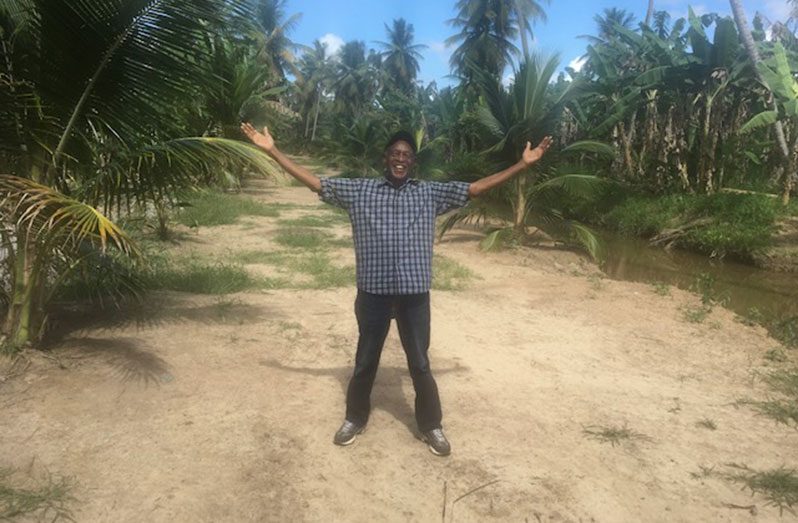By Francis Quamina Farrier
SPENDING a few hours at the 80-acre Stoll’s Coconut Estate at Enterprise on the Pomeroon River in Region Two is always an extremely informative, pleasurable and memorable experience for anyone who is fortunate to get there. As the visitor strides around that fertile agricultural enterprise, they would realise that they are at a special place in our beautiful Guyana. So, in this feature article, I will relate how it feels, at least for me, to be walking on the fertile earth which is part of an agricultural project of that magnitude. The property has been owned and developed by two generations of the Stoll family for over half a century.
Within the boundaries of the Stoll Coconut Enterprise, there are hundreds and hundreds of coconut trees. Some of those trees are about 80 feet tall and laden with lots and lots of coconuts. Many are sold as “water coconuts.” Others for copra. Some of the trees are young and not quite ready to produce nuts as yet. Nonetheless, they are expected to be producing nuts within a year or two. The ongoing production will not only keep the Stoll family financially viable, but also contribute to the livelihoods of the 80 loyal employees and their families who work at the farmlands as well as at the adjacent Adel’s Tourist Resort. Adel Stoll, who was the matriarch of the Stoll family and founder of the resort, died there some years ago. During her period as the manager of the resort, she welcomed many tourists, some coming from as far away as Australia and New Zealand, and even today, arrivals from distant lands are still the norm. Local visitors and foreign tourists alike find the Stoll Coconut Farm not only a sight to behold, but an attraction to stroll around and be one with “Coconut Nature.” Enjoying the water from the nuts is an added pleasure for tourists to Adel’s, especially when the coconut water is chilled to the right temperature.
Those of us old enough will recall when the song “Coconut Woman” was recorded and made very popular by the Caribbean entertainer Harry Belafonte in 1957. That song promotes the health value of coconut water which is consumed by many Guyanese, some on a daily basis. There are scores of water coconut ventors in Guyana who are ready to cut open a water coconut at one end and present it to a buyer to drink. Those nuts are available not only in Georgetown, but also at dozens of other roadside water coconut vendors in many other locations in the country. Coconut water is also served at cocktail receptions and other similar up-scale events.
In that Harry Belafonte song, the singer makes reference that “Coco got a lot of iron. Make you strong like a lion” and many men, in particular, take that seriously as a means of supporting and increasing their virility. No doubt, however, there is health value in coconut water which is also good for women, and the singer Harry Belafonte gives a most expressive testament in his rendition of the song “Coconut Woman.” The female back-up singers in that recording also present equally impressive support, and the song is regarded as one of Harry Belafonte’s most memorable and popular from his early singing career.
While at school so many years ago, my generation of students was taught that every single part of the coconut tree is useful to mankind, and as such, we must regard the coconut tree as being very special. Starting with the tree’s fibre roots which hold the soil together, preventing easy erosion when they are planted on the banks of canals, creeks and rivers, was the first thing we were taught. In the old days and even today, in the rural areas of Guyana, the trunk is at times used to construct low-grade bridges, while the leaves are used for low-grade roofs. There are so many other uses for the various parts of the coconut tree, including the manufacture of jewellery, ornaments and decorations, not to forget the use of branches to produce simple cricket bats and also what is called “Pointer brooms” using the stem of the leaves. The lifespan of a healthy coconut tree is about 80 highly productive years. Mention must also be made of landscaping and shade facilities, among some other more ideal uses such as somewhere for birds to perch and even build nests. Bravo to the coconut tree, a palm of elegance, the image of which is even used as the symbol of one of Guyana’s main political parties.



.jpg)








